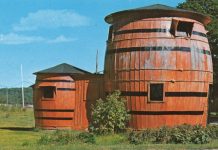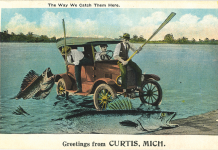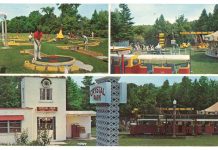
Michiganders, like other Americans, always have had a penchant for fun and amusement parks that provide a chance to get away from everyday life. From early amusement parks such as the Chutes Park in Chicago (1884) and Coney Island in New York (1885), came the craze that sprouted almost 2,000 small amusement parks around the country by 1920.
Michigan had its share. The “Golden Age” was the first 30 years of the 20th century, though many Michigan amusement parks started in the late 19th century. Most early parks had a midway lined with games of chance and dexterity, shooting galleries, food concessions and picnics areas.

Also popular were dance halls, entertainment pavilions and sports fields. Balloon ascensions and parachute jumps offered excitement to onlookers. Parks located on lakes often had boardwalks, water slides and excursion boats. Then there were the mechanical marvels: carousels, Ferris wheels, roller coasters, miniature trains, bumper cars and other motion rides.
The biggest lure was the roller coaster. About 2,000 roller coasters operated in the U.S during the 1920s. They gave riders the thrilling sensation of danger and speed and became the centerpieces of many parks.
Often located on the outskirts of towns, most amusement parks were served by streetcar lines. Some were built by streetcar companies at the end of their lines to help generate weekend and evening business. Among these were Wenona (Wenonah) Beach in Bay City and Ramona Park in East Grand Rapids.

Wenona Beach Amusement Park (1887-1964) was founded by the Bay City Street Car Company and dubbed the “Coney Island of the Lakes.” It featured a casino with entertainment, carnival games and rides, including Circular Swings, Roll-O-Plane, bumper cars and the Jack Rabbit roller coaster. Its Ferris wheel gave riders a “sky-high” view of Saginaw Bay.
Ramona Park (1897-1955) was transformed from a quiet picnic and boating spot on Reeds Lake in East Grand Rapids to an amusement park with several attractions. The Ramona Theatre Pavilion hosted plays, vaudeville acts, films and more. The Ramona Gardens Pavilion offered dancing to big bands and later roller skating. A fun house, carousel, mystic chutes, bumper cars, aeroswings and a miniature train supplied fun for all ages. The ever-popular Derby Racer (later called the Jack Rabbit) started operations in 1914 and ran on mile-long parallel tracks with an 85-foot dip. Advertisements claimed it was the steepest coaster in the country with a 75 percent grade.

One of the longest surviving parks was Silver Beach Amusement Park (1891-1971) in St. Joseph on the shores of Lake Michigan. The park’s first roller coaster, Chase Through the Clouds, opened in 1905. It was a figure-8 coaster that was relatively safe but still adventurous for its time. It was replaced in 1923 by The Velvet coaster, which was much faster as it twisted and turned over tracks high above the ground. Other attractions included a water slide, carousel, dance hall, Ferris wheel, aeroplane swing and miniature train.
Lake Lansing Amusement Park (1930-73) was preceded by Pine Lake Amusement Park before the lake’s name was changed. The park featured the Cyclone roller coaster, a carousel and dodgem car (bumper car) rides. The Cuddle Up ride used centrifugal force to slide the occupants to one side of the car and was popular on date nights.
Edgewater Park (1927-81), located on Seven Mile east of Telegraph in Detroit, featured 20 rides, with its biggest attraction a wooden roller coaster known as the Wild Beast and later the Soul Train. Walled Lake Amusement Park and Casino (1929-68), at Novi and 13 Mile, drew crowds with its Flying Dragon roller coaster, Tilt-A-Whirl and flying scooters.

Other parks had the usual rides and entertainment, but some had a shorter lifespan. Hague Park (1907-36) on Vandercook Lake near Jackson drew crowds as large as 40,000 on Fourth of July weekends. Liberty Park (1918-23) on Goguac Lake near Battle Creek was popular with soldiers from nearby Camp Custer. Jenison Electric Park (1903 to mid-1930s) was located on the Interurban route that brought folks from Grand Rapids, Holland and Saugatuck. Electric Park (1906-29) in Detroit was located on the Detroit River. With its lighted splendor, the Detroit Free Press commented it was “the greatest electrical display ever seen outside the Pan-American Exposition.”
By 1935, there were only about 350 amusements parks in the country. Most suffered attendance drops during the Depression and World War II. Some parks managed to stay open and their business picked up after the war for a few years but only a few survived into the 1970s and 1980s.
BLUE Vintage Views columnists M. Christine Byron and Thomas R. Wilson reside in Grand Rapids. They are authors of the book “Vintage Views Along Scenic M-22 including Sleeping Bear Dunes.”







Facebook Comments